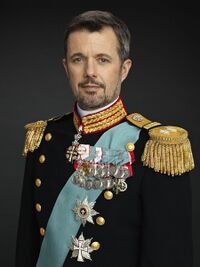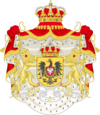Monarchy of Nikolia
This article is incomplete because it is pending further input from participants, or it is a work-in-progress by one author. Please comment on this article's talk page to share your input, comments and questions. Note: To contribute to this article, you may need to seek help from the author(s) of this page. |
| King of Nikolia | |
|---|---|
| Kralj Nikolije Król Nikolski | |
 | |
| Incumbent | |
 | |
| Aleksandar II since 7 June 1990 | |
| Details | |
| Style | His Majesty |
| Heir apparent | Konstantin, Crown Prince of Nikolia |
| First monarch | Stanislav I of Nikolia |
| Formation | 276 AD |
| Residence | Imperial Palace of Carigrad |
| Website | kraljevskakuca.nk |
The monarchy of Nikolia is federal, constitutional, parliamentary and hereditary monarchy of Nikolia. Nikolia, as a unified country, is a monarchy since Stanislav I of the House Stanisavljević unified several Slavic tribes into the Principality of Sirmia in 276 AD. The Nikolian monarchy is one of the constitutional institutions and is the highest office of Nikolia. It composes of the reigning monarch, his/her family and the supporting Royal Household of Nikolia which help the monarch execute his/her constitutional role and prerogative. The monarchy is currently represented by King Aleksandar II, Queen Irena, Crown Prince Konstantin, Duke of Sirmia, Prince Miroslav, Duke of Ister and Princess Katarina, Duchess of Katovice.
The current ruling dynasty is Petrov-Stefanović
History
Constitutional role
The Constitution of Nikolia from 1925 in Chapter IV The Monarch provides the definition of monarch's role in governing the country. The monarch, by exercising their royal prerogatives, takes advice from the government and their advisors, making sure to do so in a non-partisan way to ensure the neutrality of the crown. This convention was established by the Royal Ukase of 18 August 1961 by Queen Jelisaveta II upon her accession to the throne.
It is incumbent upon the Monarch:
- to promulgate and sanction laws
- to summon and dissolve the National Assembly of Nikolia and to call for elections
- to propose a candidate for the office of the Chancellor of Nikolia and to subsequently appoint and remove him from the office
- to appoint and remove members of the Federal Government according to the proposal of the Chancellor
- to command the Armed Forces as its supreme commander and promote its officers
- to issue decrees in accordance with the Federal Government and to confer civil and military employments and award honours and distinctions
- to keep himself informed with the affairs of the state and to, when invited by the Chancellor, preside over the cabinet meetings of the Federal Government
- to grant pardons
- to exercise patronage over the Royal Academies
